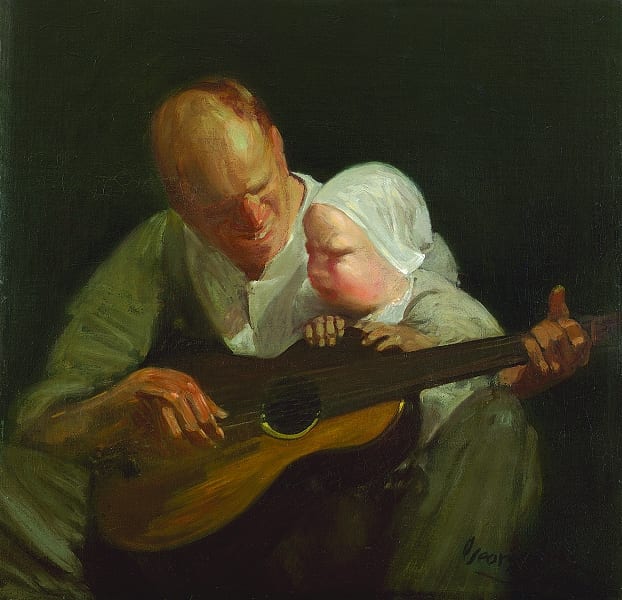 Each art museum houses strange, wonderful and utterly unique collections. Art moves from creator to multiple owners, until it somehow finds its way into a museum collection where it becomes public. This progression is often as interesting as the works of art themselves.
Each art museum houses strange, wonderful and utterly unique collections. Art moves from creator to multiple owners, until it somehow finds its way into a museum collection where it becomes public. This progression is often as interesting as the works of art themselves.
The Return to the Ashcan exhibit at the Museum of Art Fort Lauderdale (MOAFL), features 40 works of the first modern art movement in the United States at the turn of the 20th century. This movement was called the Ashcan School by dismissive critics because of the artists’ interest in the gritty underbelly and banalities of urban life that they observed in New York. The display features work by its leader, Robert Henri (1865-1929), who was an influential art teacher. A collection of his lectures, The Art Spirit was published in 1923 and remains in print today (it is required reading for many art students). Interestingly, 10 of the 40 works on view come from the museum’s own collection, most of them by William Glackens (1870-1938).
The Ashcan School is characterized by rapid brush strokes, used to preserve subject spontaneity as they do laundry, read, slog through the snow, get dressed or doze. These paintings are dark where browns and grays dominate and the sun rarely shines. The gallery walls are painted a rich brown that not only makes the gallery more intimate, but also offers a stark contrast to the South Florida sunlight. The Ashcan color palette comes from the Dutch Baroque masters Frans Hals and Rembrandt; their style comes from Claude Monet and other French impressionists of the mid-19th century. But it is the subject matter and social vision that made Ashcan distinctively modern and radical to the American audience of that era. These artists were attracted to immigrants, lower working classes and the homeless—subjects that were not worthy of serious artistic attention at the turn of the 20th century.
At that time, serious art in the United States was based on Greek mythology or scripture. Typically, its subjects were powerful, heroic or virtuous. It was radical to base art on everyday life, and even more radical to stimulate social change based on the poor and afflicted. In the mid-19th century, the French poet and art critic Charles Baudelaire declared that the artist must forsake heroes, gods and goddesses and become “a painter of modern life;” that is, delve into the world to discover its ugliness as well as its beauty.
Many of these artists, Glackens among them, also worked as illustrators for newspapers in Philadelphia and New York, documenting crime, fires and other (usually tragic) events. They developed a rapid and keen sense of observation, especially for the weak, oppressed and marginalized.
The paintings in Return to the Ashcan reveal this sensitivity to the ephemeral, transitory and ordinary actions (and inactions) that so easily escape our attention. These paintings impart dignity to their unheroic subjects. The exhibition includes several landscapes, yet none of them are scenes of reverie and pleasure. They are dark and gritty—the weary observations of a factory worker or day laborer on his way to or from work.
Return to the Ashcan reminds us that our lives are hard. In fact, the beaches, the cruise ships, the golf courses and yachts exist as testimonies that life is hard for everyone, even the affluent and powerful who need distraction and escape. Much like in New York City, it is not hard to find poverty in Broward County.
And yet these paintings reveal something more, something else. We see it in the dozing servant boy, a baby playing with his father, women planting a garden and boys throwing snowballs. In the midst of the pressure, fatigue and weariness emerges a space to exhale, rest, play and paint.
How did these dark and somber paintings of poor immigrants find their way to Fort Lauderdale, the city of sun, cruise lines, beaches and third homes for the rich and famous? After his death in 1938, Glackens’ children started a foundation, called the Sansom Foundation, dedicated to preserving his legacy (Sansom is the name of the street in Philadelphia where Glackens grew up). Sansom Foundation president C. Richard Hilker—a friend of Ira Glackens (the artist’s son) — was also a MOAFL trustee and convinced the foundation to gift the collection to the museum. They committed to base the work on Glackens, and to keep the integrity of its original social, historical and artistic context.
Hence, exhibitions like Return to the Ashcan offer a reminder that life is hard and painful; yet, amidst the difficulties and suffering, there is grace.
See this exhibition before it closes on February 24 in Fort Lauderdale’s historic Las Olas Boulevard. I will be leading a tour of this exhibition on Saturday, February 23 as part of the Liberate conference hosted by Coral Ridge Presbyterian Church. Visit 2013.liberatenet.org or e-mail me [email protected] for more details.

Comments